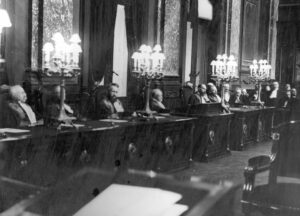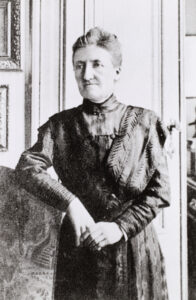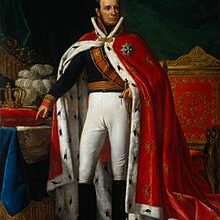Three interactive timelines are available, dealing with different topics :
- The judicial organization in Belgium, by Francoise Muller
- Women and the legal profession, by Francoise Muller
- The assize jury, by Marie Vandersanden
1. The judicial organization in Belgium, by Francoise Muller
Keywords: Judiciary, incompatibility, retirement
The Constitution of 7 february 1831 stipulates the creation of a Court of Cassation. The law of 4 august 1832 lays down the principles that govern this institution, which is set up on the following 15 october. The court then counts 2 rooms and 22 members (19 at headquarters and 3 at the prosecution service). The same law establishes a 3rd court of appeal in Ghent, next to those of Brussels and Liège
Assembly of magistrates @CEGESOMA - picture 163973
According to the article 100 of the constitution, "judges are appointed for life. No judge may be deprived of his place or suspended except by a judgment". At the time, appointment for life was understood literally: the seated magistrates, except for voluntary resignation, remained in office until their death. Over time, a growing number of magistrates suffered from more or less disabling infirmities. The legislator therefore intervened by the law of 20 may 1845 which targeted judges suffering from a serious and permanent disability for more than a year. Legislative progress remained timid and the "esprit de corps" of the judiciary hindered the application of this law which, in more than 20 years, was only applied 3 times.
Before 1848, only the magistrates of cassation must choose between the exercise of their judicial functions and political functions at the national level (parliamentarian or minister). The other magistrates are free to combine, like Jean-Joseph Raikem, both Minister of Justice and Attorney-General in Liège. In 1848, fearing that the French revolutionary context would reach Belgium, the legislator is working to satisfy the petite bourgeoisie by urgently adopting the law of 26 May which puts an end to the system of the Parliament of civil servants: a person employed by the State must choose between his function and the national representation. It is always possible, and this until the law of 18 june 1869, for a “lower” magistrate to be an extra-parliamentary minister.
At the provincial level, since the law of 30 april 1836 and until May 1848, magistrates can sit on the provincial council but they cannot exercise executive functions. The same logic applies at the municipal level where the seat of councilor will remain open to them until the Judicial Code of 1967.
The law on the organization of the judiciary of 4 august 1832 pose, as the only condition for access to the functions of justice of the peace, a minimum age, namely to have 25 years completed. It is part of the revolutionary logic which conceives the justice of the peace as a "good father" close to the litigants. The law of 1849 breaks with this model and requires justices of the peace to hold a doctorate in law.
Magistrates who have reached a certain age – age which varies according to the level of jurisdiction – will now be retired and will enjoy, if they meet the seniority conditions provided for by law, emeritus. The law of 1867 also speeds up the procedure introduced by the law of 20 may 1845 which allowed the Court of Appeal or the Court of Cassation – depending on the jurisdiction to which the magistrate concerned belonged – to retire a magistrate who was seriously and permanently incapacitated.
Judicial appointments following the passage of this legislation clearly favored the Liberals then in power.. The Catholics, well aware that the judicial movement would be unfavorable to them, suggested an alternative solution : they had, without success, proposed that magistrates who reach the age of 70 years have the choice either to request their retirement within the year and to benefit from the emeritus, either to remain in office running the risk of being retired under the law of the 20 may 1845 if their physical or mental condition no longer allowed them to perform their duties.
However, despite being a party law, we must not neglect the need to curb the phenomenon of the aging of the superior magistracy, which proved to be all the more problematic in the face of the resistance of the magistracy to the law of the 20 may 1845 which led to the continued employment of persons incapable.
The origins of this law go back to 1853, on the initiative of the Minister of Justice Charles Faider who wanted to draw up a Code of judicial organization. Early work is moving in this direction., proposing a series of modifications moving in the direction of an increased professionalization of the judiciary and an affirmation of the principle of separation of powers. Liberal minister Tesch took over the project in the 1860s but reduced it to mere coordination. Only innovation : the retirement of magistrates aged 70 years. On the proposal of the Liberals, the bill splits in the course of parliamentary examination : the question of the retirement of magistrates is examined separately and is the subject of specific legislation, marking the failure of coordination. In terms of its content, the law of 1869 turns out to be very uninnovative. Using their right of amendment, some parliamentarians will try, in vain, to make changes to the judicial organization, in particular by taking up several ideas put forward in 1853. Some of these proposed changes will be adopted in the Judicial Code 100 years later, for example with regard to commercial courts.
A first court, distinct from justice of the peace, was created in Brussels in 1911, then in Antwerp two years later. Police courts will then become widespread.
The law of 21 february 1948 opens the judiciary and all judicial functions to women, provided they have the permission of their husband. The first female magistrate is Geneviève Pevtschin, appointed judge at the Brussels Court of First Instance in November 1948.
This law also applies to the Council of State, which as soon as it was installed in 1948, has a female deputy auditor general : Marie-Therese Bourquin.
The law of 21 february 1948 opens the judiciary to women. See the timeline "Women and the legal professions".
Belgium adopts its first judicial code. Among the novelties introduced, we can mention the standardization and partial professionalization (presidency) of commercial courts or the modification of certain judicial cantons.
In the wake of the constitutional revision of the 20 november 1998, the CSJ is instituted and the mode of appointment of magistrates considerably revised
A few suggestions to find out more :
On the status of the Belgian judiciary from 1830 to 1914 : Francoise Muller , La Cour de cassation belge à l’aune des rapports entre pouvoirs : de sa naissance dans le modèle classique de la séparation des pouvoirs à l’aube d’une extension de la fonction juridictionnelle (1832-1914/1936), Bruges, La Charte, 2011, 504p.
On the professionalization of justice of the peace : Jean-Pierre NANDRIN, La justice de paix à l’aube de l’indépendance de la Belgique (1832-1848). La professionnalisation d’une fonction judiciaire, Brussels, Saint-Louis university faculties, 1998, 314p.
On the establishment of a single judge : Jean-Pierre NANDRIN, « Le juge unique en Belgique. Quelques jalons historiques d’une révolution tranquille », in R.I.E.J., 1989, n°23, p. 97-113
2. Women and the legal professions, by Francoise Muller
Keywords: Feminization, bar, judiciary
By his judgment of 12 December 1888, the Brussels Court of Appeal denies Marie Popelin access to the bar. The appeal in cassation of the latter is rejected on 11 november 1889.
*Excerpt from the indictment of Attorney General Van Schoor
The organic law of 15 may 1910 on employment courts("Conseils de prud'homme") makes women eligible. In France, this was the case since 1908 (law of 15 november).
Thirty-four years after the Popelin affair, women are allowed access to the bar (except cassation). Married women must have their husband's permission to exercise. They are also prohibited, unlike men, to stand in for a magistrate.
The first two women to call the bar, the 8 next may, are Paule Lamy and Marcelle Renson. Paule Lamy will be the first woman to plead in the Assize Court.
We must wait 1968 so that a woman, Odette Virlee, become president.
Law of 13 june 1924 relating to the electorate, eligibility and elections for the formation of commercial courts.
A French law of 11 april 1946 allows women to pursue the career of magistrate. Under feminist pressure, Liberal Justice Minister Van Glabbeke seeks advice from public prosecutors on the matter. Unlike the other two prosecution services, Liège, through the Acting Attorney General Delwaide, will be particularly opposed to it, as evidenced by its famous "mercuriale" of 1946 entirely devoted to the question.
Wivine Bourgaux is the first woman to plead before the Court of Cassation.
The law of 21 february 1948 opens the judiciary and all judicial functions to women, provided they have the permission of their husband. The first female magistrate is Geneviève Pevtschin, appointed judge at the Brussels Court of First Instance in November 1948.
This law also applies to the Council of State, which as soon as it was installed in 1948, has a female deputy auditor general : Marie-Therese Bourquin.
Odette De Wynter (1927-1998) is the first female notary. Herself the daughter of a notary, she got her degree in 1950 and will be nominated, five years later (royal decree of 20 june 1955), in Auderghem. His training supervisor will advise her to mention only her initial on her nameplate.
Ten years after the enactment of the law, seventy women were graduates but only four appointed notaries.
To know more, consult : Jean-Pierre NANDRIN, Hommes et normes. Enjeux et débats du métier d’un historien, ed. P.-O. DE BROUX, A. HENDRICK, F. MULLER and B. PIRET, Brussels, Presses de l’Université Saint-Louis, 2016, p. 497-518.
On the web: podcast of the symposium Le juge est une femme, organized at the ULB on 7 and 8 november 2013.
3. The assize jury, by Marie Vandersanden
Keywords: Judicial organization, justice reform, assize courtThe laws of 29 september - 21 october 1791 organize the criminal procedure. In particular, they confer considerable power on the justice of the peace and make the popular jury an essential player in the judgment.. The grand jury is made up of 8 citizens drawn by lot and is presided over by an elected judge (district court judge) ; he decides whether or not to refer the defendant to the criminal court. This criminal court, one per department, includes the trial jury composed of twelve citizens chosen by lot.
If the principle of trial by jury is of English origin ("trial by jury"), it was during the incorporation of the Belgian provinces into France, that the two-jury system (accusation and judgment) is introduced in "Belgium".
The assize court system, imported from France, is governed by the French criminal investigation code of 1808. Like all other legislative works from the beginning of the 19th century, this Code is a work of compromise or rather of superposition between the conflicting terms of the two previous legislations : the royal decree of 1670, i.e. the Code of Louis XIV, the laws of 1791, i.e. the Code of the Revolution. It is born from a vast reflection on the criminal question, and enshrines popular ownership of criminal procedure through the introduction of two juries (accusation and judgment). The indictment jury quickly fell into disuse to be finally replaced by the indictment chamber of the court of appeal.
In 1814, the fall of the French Empire leads to an allied tutelage of Belgium. The 6 november, a decree of William of Orange, in his capacity as Governor General of Belgium, abolishes the institution of the jury in the southern provinces. After the Congress of Vienna, Belgium falls under Dutch domination where the courts of assize remain but without jury.
Article 98 of the constitution declares : "The jury is established in all criminal matters, political and press offenses". The abolition of the jury being one of the grievances against the Dutch regime, the goal in 1831 is to restore the institution in the first instance and perfect it once in operation. The terms of the French Criminal Code of 1808 relating to the jury are therefore brought back into force.
The jurors must be taken from Belgian citizens paying a certain tax (different depending on the province) or, apart from any contribution, among a certain category of persons automatically placed on the jury rolls (e.g : mayors, aldermen, doctors of law, notaries, etc.). Some people are exempt or removed from the list such as people over the age of seventy, ministers, ministers of religion, active duty military, etc. The law of 15 may 1838 also introduces the mechanism of correction of crimes which empties the assize courts of their substance. This mechanism consists for the prosecution and the investigating courts, to admit extenuating circumstances or a cause for excuse in order to refer the judgment of the crimes to the criminal court, normally reserved for the assize court and therefore for the jury.
"No one can be sworn, if he is not Belgian by birth, if he did not obtain the great naturalization, if he does not enjoy civil and political rights and if he has not completed thirty years"
(Art. 97, L. on the O.J.. 1869).
However, to be part of the jury, it is not enough to fulfill these three conditions, the special conditions provided for by the Law of 15 may 1838 are always required : a contribution to the State of a certain amount, an exemption for certain citizens as well as the automatic addition to the jury list of certain categories of people. The permanent deputations of the provincial councils are responsible for drawing up annually, for each judicial district a general list of persons qualified to be jurors.
The law of 23 August constitutes the first major reform of the institution : the court and jury are now collaborating on sentencing. This collaboration tends to create a counterweight to the indulgence and clemency of jurors. Indeed, for a long time, a jury contestation, relayed by the press, the judicial world and public opinion, was orchestrated around a major theme : that of "scandalous acquittals". Following too great an identification with the condemned and the fear of too severe a sentence for him, some juries were too lenient. The judicial world thus saw its investigation led to harm by a verdict of acquittal. The law of 1919 as well as the increase in the number of correctionalized crimes aim to reduce the number of wrongful acquittals.
The law of 1930 changes the composition of the jury. The number of people who can act as jurors is extended. The tax is no longer a necessary condition for the function, on the other hand, education becomes essential : "they (the jurors) are asked if they can read and write and what is their national language". Persons who do not speak the language of the trial are automatically rejected. The question of access to jury duty for women has arisen in particular, but the legislator has made no provision preventing them from being part of a jury of assizes.. Since the law of 1930, the jurors are therefore selected on the basis of the list of voters.
If the legal system remained marked for a long time by the French occupation and by few modifications, at the end of the years 1990 reform proposals are starting to stir up the debate. The Assize Court and its popular jury are increasingly criticized. The law of 2009 does not rule out the possibility of a progressive abolition of the assize court but is content to modify certain essential elements of the procedure. It aims at the duty to state reasons on the guilt decision of the popular jury. In accordance with European obligations (jurisprudence Taxquet), the legislator provides that jurors must give reasons for their answer to each of the questions relating to guilt. The court then writes, in the aftermath, the reasons for the verdict.
The pot-pourri II law or "law amending criminal law and criminal procedure and laying down various terms in matters of justice" follows the pot-pourri I law of 19 october 2015 on civil procedure. Its objective is to adapt criminal law and criminal procedure in order to accelerate and simplify procedures. By the possible correctionalization of all offenses, the assize procedure becomes an exceptional procedure applied for the most serious criminal acts, for example those committed against police officers or involving minors and for which the family opposes correctionalization. The President of the Assize Court and his two assessors, considered more adept at estimating the value and legitimacy of evidence, now participate in the deliberation on guilt. Therefore, when deliberating on guilt and sentencing, these three professional judges constitute with the jury a "college".


